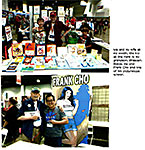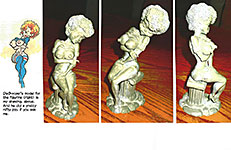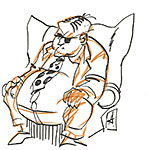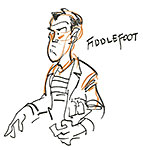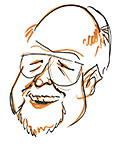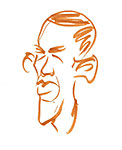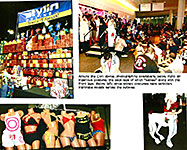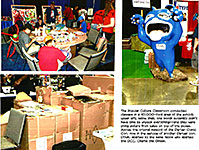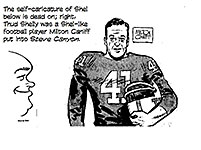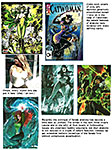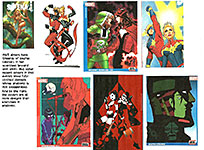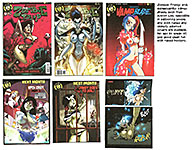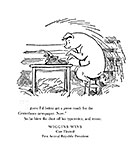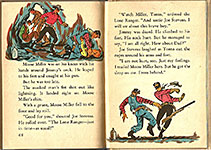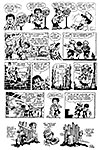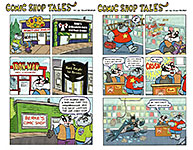 |
||||||||||||||||||
|
Opus 368 (July 27, 2017). This time, we ponder some of the mid-summer nightmares in comic consCthe Good, the Bad, and the UglyCreporting on the Denver Comic Con and controversies about the San Diego Comic-Con (booth prices, services, hotel rates, declining attendance, and origins). Also: increasing sexless covers on comics, the Harvey Girl, and a new comic strip. Meanwhile, it=s still our annual Open Access Month here at Rancid Raves_ All the usual $ubscriber walls and barricades are down, and all you fly-by recipients of this e-missiveC you and anyone in your family (or neighborhood) (or country)C can partake of the casserole of news and reviews that is Rants & Raves (including 18 years of archives) and visit our history department, Harv=s Hindsight, at leisure without having to pay our paltry subscription fee. Tell your friends. Tell your acquaintances. Tell your enemies. For the next three weeks, you can join us in hoppin= down the bunny trail of comics news and reviews, cartooning history and lore. Here=s what=s here, in order, by departmentC:
THE SEASON FOR GETTING CONNED Denver Comic Con 44-Year Vendor Quits Sandy Eggo Rozanski=s Letter Announcing His Quitting Sky-high Hotel Room Rates in San Diego How To Negotiate Hotel Room Rates: Strategies Veteran Vendor Critiques Comic Cons San Diego Comic-Con Defends Itself
SOMEWHAT SKEWED HISTORY OF THE FOUNDING OF THE SAN DIEGO CON How It Sullies the Reputation of Its Founder What=s Wrong with This History; Its Founder Defended
FUNNYBOOK FAN FARE Bosoms and Buttocks
GOSSIP & GARRULITIES Book Selling (and Buying) Freddy the Pig Ted Shearer
ONWARD, THE SPREADING PUNDITRY Trump Distractions Trump Killing the GOP
COMIC SHOP TALES A New Comic Strip (Only in Previews)
HAPPY BIRTHDAY To Thoreau
QUOTE OF THE MONTH If Not of A Lifetime AGoddamn it, you=ve got to be kind.@CKurt Vonnegut
Our Motto: It takes all kinds. Live and let live. Wear glasses if you need =em. But it=s hard to live by this axiom in the Age of Tea Baggers, so we=ve added another motto:. Seven days without comics makes one weak. (You can=t have too many mottos.)
And our customary reminder: don=t forget to activate the ABathroom Button@ by clicking on the Aprint friendly version@ so you can print off a copy of just this installment for reading later, at your leisure while enthroned. Without further adieu, then, here we goC:
THE SEASON FOR GETTING CONNED The Good, the Bad, and the Ugly Where Are the Comics At Denver, San Diego, and Elsewhere? The sixth annual Denver Comic Con was attended by about 115,000Cequal to last year=s extravaganza but in early publicity, the management was hoping for (and touting) 125,000. An audit of 2016 is still in progress, but early estimates predict revenue at $3.93 million, a modest increase over 2015's $3.4 million; and this year=s take should fall in that range. Like most comic cons these days, the DenComCon is a combination of craft show and costume parade with funnybooks lurking in the distant background. Artists AValley@ (a nod in fanciful nomenclature to the Con=s locale in the shadow of the Rocky Mountains) occupied about half the show area in the Denver Convention CenterCwith 240 independent artists. No major comic book publisher (DC, Marvel, Dark Horse, etc.) was in evidence. The Con=s guest list included (sez here) 200 guest authors and comic creators, 250 vendors (in Merchant AMesa@), and about 40 celebrity guests (mostly tv and film actors), signing autographs in a special arena set up for that purpose. The
program booklet had 3 pages listing tv and film actors guesting at the Con, 2
pages of Aauthors,@ and 5 pages of comics artists and related personages. I had a table in Artists Valley and had a great time. A couple acquaintances from previous ages showed up, surprising the heck out of me: he came marching up to the table with a grin on his face and his hand extended. Didn=t know who he was. It was Dave DeGooyer, whom I haven=t seen in 20 years. He sculpted a Harvey Girl 25 years ago at the Sandy Eggo Con. And a woman who wanted to know if I knew Gene Tool. (I did: I met him here in Denver when I was a cartooning teenager, and he was writing a comic strip that he and the artist hoped to sell; alas, the strip didn=t make it.)
DeGooyer created his figurine using one of my lewd cartoon lady pin-ups as a model. I received the first casting, and Dave sold six or seven of them before the mold began falling apart: the hair was too detailed to endure very long. Thereafter, he always said he learned a lot doing the Harvey Girl. I toured the exhibit hall and found valuable treasure to spend money on, but I managed to bank most of the revenue my table generated. I sell my books at my table, and I also do caricatures, more this year than in previous years. I did a caricature or two before I remembered a new trick that I intended to try: instead of penciling a rough, I=d do a rough sketch with orange or buff marker, then, after having located the chief features of the picture, I=d ink it with a black marker or pen. Saves time; isn=t as messy as penciling and erasing. And the color lines, rough though they may be, add an attractive dimension to the picture. Here are some sketches I made in that mode several years ago when expiring of ennui at some meeting or another.
The first, a nameless fat guy; the second, a sketch of my Fiddlefoot comic strip character; the third (can=t remember exactly, but) I think is an actual portrait of someone I=ve long ago forgotten; and last, ObamaCwithout black inking. Not a bad caricature, I weenCat least as useful as most of those tooth-pick thin figures that paraded before us for 8 years. The art of political cartooning no longer requires caricatures of political dignitaries that look much like the subject. Each editoonist develops his own individual Atake@ on the person, a simple albeit idiosyncratic glyph, then uses it again and again. Readers Arecognize@ the glyph as visual shorthand for the politician depicted even though it doesn=t look much like him or her. There are exceptions. Jack Ohman=s caricatures are superb; ditto Ann Telnaes. And there are others doing good caricatures. But many more are simply manufacturing a glyph that will work, becoming, in repeated usage, a symbol for the politician being depicted. That=s changed, now, though. The Trumpet=s hair and mouth are so peculiar and recognizable that everyone achieves a likeness without having to work very hard. Hair, check; lippy mouth, done. For the ease of execution, we have the Trumpet to thank.
THE DENCOM PROGRAM offered 500 hours of informational and promotional panel presentations and a 10,000-square-foot Kid=s Lab in the exhibit area with creative activities for children and teens. Presentations used 24 meeting rooms with hour-long panels from 10:30am to 6pm daily, but only four of the rooms featured comics topics, one room devoted to scholarly Aliterary@ subjectsCHawkeye through the Ages, The Storm: Feminism in Comics, Will the REAL Captain Marvel Stand Up, and the like. In the other rooms topics ranged wildly across the varied interests embraced by the ConCThe Music of Star Wars, The Art of Voice Actors, Fandoms As Social Movements, A Creative Life (Business and Balance), The Power of LEGO, Cosplay in the Classroom, We Can Be Heroes (Symbolism of Superheroes in Your Curriculum), Analyzing Sequential Art (Teaching Teachers to See Within and Between the Panels), Life with Archie, Death of a Zombie, From Page to Screen, Drawing with Frank Cho, How to Draw Manga, Drag Meets Cosplay, The Movies of 1982, Steampunk v Cyberpunk, Pairing Comics and Chapter Books in the Classroom, Video Game Literacy, Doctor Who, Model Kits, Women in the Geek Industry, The Greatest Kaiju Movie of All Time, Diversity in Comics (Are Things Really Changing?), My Little Pony Comics, Writing Comics v Writing Novels (What=s the Difference?), Making and Modeling Your Own Costumes, Kicking Butt in Corsets, The Screenwriting Process, and on and on. The DenComCon differs from most comic cons: it is programmed and run by Pop Culture Classroom, an educational non-profit that provides (in addition to the Con) Ahigh quality educational resources to school districts, teachers, and community organizations,@ using comics as the spark to teaching creativity. A AStorytelling through Comics@ curriculum promotes artistic and literacy skills using comics, Pop Culture Workshops and Educational Camps harness existing interests in pop culture topics to create one-of-a-kind learning experiences for students and teachers, and AGame On@ is a play-based curriculum in which students develop their own board games. PCC also produces a free, bi-weekly comic strip that educates students about diverse characters and events from history, and it offers professional development for educators in learning about pop culture from leaders in the field. Because of the PCC sponsorship, the Con aims to be especially family friendly, emphasizing a AKeep it PC@ policy in cosplay: exhibitors and guests are encouraged to wear sports bra-like coverage on top with leotard-type coverage on bottom (i.e., no butt cheeks, thongs, or Aplumber=s butt cleavage@ or bare chests, singlets or Vampirella-type costumes with necklines that plunge to the groin). And this year, the Con adjusted and revised its policy on cosplay props, essentially banning any realistic-looking guns, and doing bag checks at the entrance. Some cosplayers complained that the policy on make-believe weaponry was introduced at the last minute, taking them by surprise and preventing their entrance, but I wonder about the Alast minute@ allegation: the Denver Post carried a story outlining the new policy several days before the Con. In any case, the parade of costumes by my table was continuous and varied. Few cosplayers, however, carried purses or wallets, from which we can surmise that they weren=t there to buy anything. But the parade was fun to watch.
The San Diego Comic-Con will be history by the time you read this. If it inspired any unusual antics or illegal activity, I=ll report next time. This year, as I announced last year, I didn=t attend: last year was my 25th consecutive Sandy Eggo Con, and I=m 80 years old now. Two nice round numbers signaling that=s enough Sandy Eggo Con for one lifetime. Besides, the cost of hotel rooms in San Diego has soared beyond the reach of ordinary citizens, and I choose not to participate in the scam any more. And so did Chuck Rozanski of Denver=s Mile High Comics, reputedly the world=s largest comic book store. He=s been exhibiting continuously at San Diego Comic-Con for 44 years, since his first in 1973. Established in 1969 in Colorado Springs, Colorado, Rozanski's Mile High Comics has grown to be a three-store retail chain in the region with a large mail-order and online retail component, now headquartered in Denver. Rozanski had spoken out previously about declining sales at SDCC, but continued to exhibit until this year. Citing poor foot traffic and poor management by SDCC, he voided his $18,000 check and cancelled his booth space. Declining revenue would be reason enough to quit, but Rozanski might have kept on except for the treatment he endured last year. On Tuesday, facing a 6pm Wednesday opening, he and his staff waited all day, from 7:30am to 9pm for Comic-Con=s green light to move Mile High=s leased 45-foot semitrailer, holding seven booths and 100,000 comic books, from a staging area. They never got the promised go-ahead. AIt=s hard to differentiate between incompetence and malice,@ said Rozanski. AOne would hope that there was no malicious intent, but leaving us sitting there with 12 employees for the entire day of Tuesday and not even having anyone from the convention staff come by and say, >Hey, we=re having a problem.=@ The next day, opening day, his team had only eight hours to set up a custom Amobile comic book store.@ And no apology from management. Rozanski calls his decision to quit Areally gut-wrenching,@ he told Ken Stone, who reported all that follows online at some undisclosed URL. AYou have to understand,@ he explained by phone from his ACathedral of Comics@ in Denver. AI raised my children at this show. My four daughters used to sleep in bassinets underneath our table when we were selling over at the Civic Center.@ Since age 17, when he paid $40 to rent a table at the 1973 convention, Rozanski hasn=t taken a single summer vacation, he said, because AI have done San Diego nonstop.@ But after last year=s event, Rozanski says he became disenchanted with the attitude of folks running the show. AThey feel they can just do anything the want, pay themselves nice big fat salaries and suck up to Hollywood,@ said Rozanski. AAnd that is their main goal in life. As long as they=re making Entertainment Weekly happy, they can give a rat=s ass whether [comic-book vendors] live or die.@ (SDCC would contest this characterization, see Sandy Eggo=s Position down the scroll.) Comic-Con C a 501(c) nonprofit whose last reported annual revenue, in 2015, was $19.8 million C did not respond to Ken Stone=s request for comment.
AT THE END OF LAST YEAR=S COMIC-CON, after Rozanski had lost $5,000 overall, he paid $18,000 for space in this year=s show. But in February, he called for his check to be voided. Comic-Con eventually informed him of Asomething they were keeping secret, which was that the fire marshals had restricted their access to some of the loading docks in the back.@ Had officials leveled with him at the time, it wouldn=t have Afunctionally@ made a difference, he told Stone, Abut Y I could have sent my guys home. >Hey, we=re not all going to sit here and eat deli sandwiches and drink Coke all day long wondering when our freight=s going to arrive.=@ Rozanski publicly announced the pullout Wednesday, July 12, via a 700-word email newsletter (which we reproduce below). Reaction on social media was Aintense.@ On Mile High=s Facebook page, Kevin Deselms said: AThis is SDCC forgetting where it came from because it=s suddenly the toast of Hollywood.@ Jason Kleinman added: AIt=s such a shame. I miss the old days when comic book shows were in dark out-of-the-way hotel conference rooms and the only people who went to them were comic fans who found out about the show from their comic shop_@ Cho Jitsu called Comic-Con a Ajoke.@ AI remember when SDCC was about comic books, artists, inkers and the writers,@ Jitsu said on Facebook. ANow it=s just a media circus promoting everything beyond just the comic book stuff. Now it=s just about waiting in line to buy the next toy.@ Rozanski said he spent a couple hours online Thursday morning, July 13, and saw Athe better part of a thousand comments on various websites.@ AThey [SDCC managers] care about us to the extent of putting on panels and having creators there C at least the top-line creators,@ he said. ABut at the end of the day, they really do not care about their vendors, because they view their vendors as being completely interchangeable.@ He said if Mile High didn=t buy a booth in the cavernous Exhibition Hall, Comic-Con would just sell the space for a higher amount to a Ajewelry salesman or a poster seller or somebody selling Medieval clothing. Y San Diego has become a flea market under a tent. ATo explain,@ he went on, ASan Diego has grown far beyond its original premise, morphing from what was originally a wonderful annual gathering of the comics world, into a world-renown pop culture and media festival. As such, it has seen rapidly escalating costs, and also a dramatic change in the demographics of its attendees. Neither of those changes worked to our advantage._ Michael Cavna, longtime Comic Riffs columnist for the Washington Post, said he and director Tim Burton had a chat at 2009 Comic-Con about how Awhen a comics fest becomes a huge pop fest, the soaring costs can squeeze out smaller exhibitors first.@ Cavna, who earlier worked at the San Diego Union-Tribune, called Mile High=s pullout Aa continuation of the great transformation.@
ROZANSKI OFFERED NO HARD DATA, but said he=s seen Aa steady attrition@ of comic-book vendors at Comic-Con. AActually maybe half of the dealers seven years ago are gone,@ or perhaps more, he said. His wasn=t the only vendor not to renew this year, he said. He cited other reasons for the shrinking turnout of comic-book sellers at the event. Floor traffic to his seven-booth display was down as much as 50 percent, he said, partly because of the lure of Comic-Con events outside the San Diego Convention Center. AAt the end of the day, that=s what I think is going to kill the show C that the city of San Diego has said: >Oh my God; this is such a good thing. Let=s have all kinds of things outside the Convention Center.= It ends up being a death of a thousand cuts,@ he said. Six days= lodging also became too expensive C the result of what he called horrific gouging. AAt the Hilton, they were charging $299 and they wanted to bump it by another hundred,@ he said. AI was paying a $5,000 to $6,000 hotel bill [for his crew]. That=s a lot of $4 comics.@ We examine the hotel room rate issue further down the scroll under AHotel Room Rates.@ Rozanski concedes he heard contrition once from Comic-Con C when he asked for his check to be canceled. AAll of a sudden they were profusely apologetic,@ he said. ABut when people treat you with such utter disregard, and you=re already dealing with an economically marginal endeavor, you just feel like there=s no point in coming back.@ He=s also hurt by the lack of appreciation for a pioneer vendor. AWhen you=ve done a show like we have for 44 years, and you helped raise money when the show was on the edge of bankruptcy back in the late =70s, and did things for them that you didn=t have to do, and now they screw you over and can=t even come over and say they=re sorry? I have a lot of other options in my life.@
Rozanski=s letter (in italics): To answer the numerous questions that we have been receiving of late, for the first time in 44 years, we will not be exhibiting at this year's San Diego Comic-Con. I wish that this decision could have been otherwise, but circumstances beyond our control made our further participation impossible. To explain a bit more, my first little one-table booth in 1973 cost $40 to rent for the weekend. When we received our booth renewal for last year, our costs for our 70-foot space had been raised to over $18,000. While quite costly, that one factor alone would not have precluded us from returning, as we had paid $16,500 in rent the previous year. What made the situation nearly impossible, however, was that foot traffic in the exhibit hall declined dramatically last year. Even at its peak on Saturday afternoon, our end of the building (which was primarily comics) was uncrowded. The San Diego fire marshals were partially to blame, as they put much stricter controls on the number of badge holders allowed in the building at any given time. That might not have been such a bad idea, except that it amplified the harm already being caused by the incredible proliferation of off-site events that are now being set up for upwards of eight blocks all around the convention center. When you can see Game of Thrones, Pokemon, and hundreds of other exhibits across from the convention hall for free, why bother going in to the hall? Many fans did not. To summarize, we experienced rising costs, while at the same time foot traffic in our booth plummeted. That is never a good combination. That having been said, I truly loved the experience of exhibiting at San Diego Con, so I can assure you that I would have ignored those two major obstacles, and still renewed my booth. The final straw, however, was the utter indifference of the San Diego Comic-Con management to the fiasco that we endured at the beginning of last year's show, when the freight handlers that they hired failed to deliver our comics to our booth. So
how could this awful thing happen? It beats the heck out of me. Our trucker was
in line at the convention marshaling yard at 6:30am on Tuesday morning. At 9pm
that evening, with almost all the other vendors around us unpacked and
completely set up, we still did not have our 40,000 lbs of freight. I had
twelve workers scheduled to help us set up that day, but all we could do was to
sit around all day in our totally empty booth space. Making matters much worse, at no time during this ordeal (or during the show) did anyone from the convention management stop by with an apology, an explanation, or even just to commiserate. After 44 years of my supporting them through good times and bad, that was just too much indifference to endure. When you are in a relationship out of love and passion, but the other party could care less whether you live or die, you have to realize that it is time to move on. I will very much miss San Diego, but I doubt if the convention management will even notice that I am gone. Such is life.
Hotel Room Rates. A cursory glance at San Diego hotel room rates listed online in various places suggests that the room rates being charged during Comic-Con are not discounted. Usually, hotels offer discounted rates to conventions that book blocks of sleeping rooms. Doesn=t look like that happened in San Diego. In fact, it looks very much like the hotels are gouging Con attendees, taking advantage of the heightened demand for rooms to charge as much as they think the traffic can bare. I spend 30 years as a convention manager, and much of that time, I spent negotiating with hotels and other convention facilities over rates. In negotiating room rates, a convention has a lever to pull: a greater than normal (for the hotel) number of occupied room nights. The overriding desire of a hotel is to fill its guest rooms. A convention can do that. To lure a convention into its rooms, a hotel usually offers discounted room rates. The situation in San Diego suggests that the Ausual@ doesn=t prevail. That may be because hotels don=t feel they must offer special reduced rates in order to fill their sleeping rooms. San Diego is probably a good summer destination for ordinary citizens who aren=t attending a convention: they go to San Diego for the sunny climate and recreation. And they go in sufficient numbers of weekends to occupy many hotel rooms. AMany@ but not Aall.@ Hotels are happy to see such tourists come: they pay the hotel=s prevailing rate, nothing special, nothing discounted. Let=s say a hotel=s prevailing rate is $300/night over a summer weekend. A tourist=s stay is probably two nights, Friday and Saturday; two room nights, that=s $600 in revenue for the hotel. To book a convention, the hotel must forego this juicy revenue. Why would it do that? Because the hotel doesn=t fill up the rest of the week, Sunday through Thursday. It may run 70% occupancy. That=s fine. Hotels can live with that. But the Sandy Eggo Con could fill the hotel Wednesday through Saturday; that=s four room nights. And early arrivalsCexhibitors mostlyCtake a bunch of rooms on Tuesday, too. Figuring Con attendees fill the hotel for four nights, a hotel could discount its rooms 50% and still make the same revenue as it would make on a populous weekend: four nights times $150 equals two nights at $300. Why would a hotel offer such a steep discount? Because it has more than rooms to sell. It also has a gift shop and restaurants. Most people staying in a hotel eat breakfast, at least, in the hotel restaurant (or order room service). Four morning breakfasts is better than two morning breakfasts. But I doubt that anyone in the management phase of the Sandy Eggo Con sits down to negotiate room rates with hotels. I doubt that anyone discusses with hotel sales personnel the virtues of four nights occupancy vs two nights occupancy. I think they ask: what=s the convention rate? And the hotels answer, $300/night, double or single occupancy. And that=s it. End of negotiation. The hotels, knowing they have rank novices on the other side of the table, don=t discount muchCif at allCin quoting Aconvention rates@ for the Con. Why should they? The Comic-Con is a gold mine just waiting to be plundered. David Glanzer, Chief Communications and Strategic Officer for the Con, was interviewed by Rob Salkowitz at ICv2 recently, and Glanzer admitted that the hotel room rate in San Diego during the Con is Ahigher than what the ordinary room rate would be.@ That=s because the hotels are threatening to reduce the number of rooms they=ll hold for Con registrants. In order to get the hotels to hold maximum numbers of hotel rooms for the Con, the Con negotiators agree to higher than usual room rates. What bullshit. The Con=s negotiators are swallowing the hotel=s line. Threatening to reduce room blocks is merely a negotiating ployCdesigned to get Con officials to do exactly what they=ve done, let hotels charge sky-high room rates. No hotel is serious about reducing its room block. No hotel will turn away sure-thing room occupancyCmaximum number of room nightsCif given a choice. So the hotels have buffaloed the Con negotiators into accepting the hotel=s dealCthe seller=s dealCnot the buyer=s deal. And what do the Con negotiators have to counter the hotels threat to reduce their room blocks? Four nights of maximum room occupancy. No hotel will turn that away on the iffy possibility of attracting tourists for those four nights even at the higher prevailing rate. To test this theory, when faced with a hotel threatening to reduce its block, Con negotiators should respond: AOkay, we see your problem. And to help you out (a little sarcasm here), we=ll let you drop off the hotel housing list for the Comic-Con. We=ll do the Con without you.@ If the hotel doesn=t immediately change its tune, the Con negotiator should say Agood-bye,@ and promptly thereafter phone the San Diego Convention Bureau and tell officials there that the bad-actor hotel is hazarding the whole arrangment: hotels like that will persuade the Con to take its business elsewhere. Convention Bureau people know that. And they=ll bring pressure on the delinquent hotel to be more reasonableCto keep its room block at maximum and not raise room rates. I don=t think SDCC personnel realize how powerful a negotiating position the Con occupies.
THERE ARE OTHER NUANCES to explore in the San Diego situation, no question. And it=s not quite as simple as I=ve depicted it here. But it=s close enough to suggest the sort of maneuvering that should transpire with hotel room rates. Alas, it=s clear that the Con long ago lost its negotiating edge. Hotels know the Con wants to stay in San Diego. That gives the hotels an advantage: they know the Con is a sure thing, so why offer any special inducements (like low sleeping room rates)? That advantage means Con negotiators lose, from the get-go. In order to reinstate the proper relationship between the Con as a gigantic revenue-producing opportunity that hotels will discount room rates to get, the Con will have to move out of town for at least one year. Yup. The real secret to successful negotiating is this: you must be willing to walk away if you don=t get a deal you like. Anaheim, here we come. One year there, and the San Diego room rates for the Con would drop precipitously. The Con can=t afford to meet out-of-town? It=s staffed by residents of San DiegoCvolunteer labor, FREE_C and it would give up that resource if it met somewhere else. True. But the Con has a huge bank account; $19.8 million revenue in 2015. The Con has expenses, too: running an efficient city-wide shuttle bus system costs big time. Such expenses are covered by its income. Still, it has a bankroll. And with that bankroll, it could afford to pay for a lot of labor in Anaheim or Los AngelesCfor one year. And after that, the Con would return to a San Diego the hotels of which would be more welcoming than previously of late. The Con management, however, has its eye on more than hotel room rates. As Glanzer says, high hotel room rates are Asomething the hotels really want, and we hope that it=s something our fans can afford.@ We Ahope@? But the Con is meanwhile negotiating rates at the Convention Center, which is controlled by the city. My bet is that the Con gets a steal at the Center because the city recognizes the Con=s value: to the local economy, every dollar a convention-goer spends in the city has the economic effect of four or five dollars circulating through the city. Rates at the Center affect the Con=s bottom lineCnot the fans= bottom linesCso naturally the Con is eager to get good rates at the Center, to hell with the fans. AWe hope the fans can afford@ the hotel rates.
A Veteran Vendor Critiques Comic-Con. A couple months ago, Bryon@miniworld on comicsbeat.com took a long somewhat rambling look at the Sandy Eggo Con and other exploding cons around the country and found them wanting. He established his credentials first by saying he=d been vending comics for 28 years, then he plunged in: AThe current state of the industry has become incredibly oversaturated with >major= conventions, to the point where it=s almost impossible to even find enough vendors to fill the halls. ... AUnfortunately, the industry has also priced itself totally out of the grasp of some vendors. With major conventions requiring $1,000 to as much as $2,000 per booth, a vendor=s ability to profit from any >major= show has become an issue.@ Part of the problem, Bryon says, is ASuperstar@ guests who put in appearances but only if they=re guaranteed, say, $200,000. If a guest doesn=t make his/her guarantee by signing autographs, the Con makes up the difference. That payment comes out of the con=s Abank@Ci.e., the revenue it derives from booth prices. To pay soaring Superstar fees, the price of booths skyrockets. And at the same time, the vendor=s ability to recoup his/her investment diminishes: AIf the people all line up to pay a Superstar $150 for an autograph, there=s no money left to spend with the vendors.@ With the urge to sign up the Abig guests,@ the biggest place that has been hurt is Artists Alley. AThe industry has forgotten these are the people who built the industry and are the future of it. When I enter an exhibit floor and see the artists tucked into a corner I shudder,@ Byron said. And vendor sales at cons is in decline, Bryon says. AI have been listening to many vendor friends, and I have been told that sales, starting in mid-year (June/July) last year, have been on a sharp downturn at conventions. Some say as little as 10% but many claim 30-50%. Now, if you take 30% of sales away from an already burdened retailer, you leave them no choice but to not return. I myself have seen about a 25% downturn; but, I have also adjusted my product base to counter it. AWe have seen the average customer spend less and less at every convention, and it=s not due to stale product. It=s mostly due to oversaturation of guests, price of tickets, and the general economy.@ That=s at the big shows. Small, one- and two-day cons are experiencing an upturn in attendance compared to the Abig box@ shows, which, Bryon says, are experiencing a downturn in attendance. And at SDCC a lot of the attraction is outside the Convention Center at special events concocted to draw in fans. And they do. They draw fans in and away from the vendors exhibit in the Center. Bryon continues: AA lot of people will say the San Diego Comic-Con gets a bajillion people. Sure, they do. There is no arguing that. But, how did the vendors do? I spoke to many vendors who have pointed out that rising costs ... have almost left them broke even after decent sales. Just because you get 100k people does not mean you have happy vendors.@ Except at the smaller shows, where Bryon reports Adramatic@ improvement in attendance. He remains optimistic, expecting a renaissance of sorts. AYou will finally start to see rows of old comic boxes, books, and artists having their moment again. Its already starting to begin.@ What=s a comic con without comics, he asks. But the growing number of cons threatens his sanguine prediction, he says. ABasically put, there are too many conventions in the industry. ... The amount of conventions is creating a choke hold on the economics of the fan base. There is only so much >disposable= income for a fan to have. When you have 7 conventions that will claim attendance of 50-100 thousand people on the same weekend in March, April, May and June, it has the effect of shrinking fan dollars. ... And shrinking dollars equal shrinking profits.@ And as profits shrink, so does vendor attendance at major cons. And without vendorsCno con.
Sandy Eggo=s Position. In his interview with ICv2's Rob Salkowitz, David Glanzer, Chief Communications and Strategy Officer of the Con, strenuously maintained that Aprotecting the relationship between attendees and exhibitors and giving those dealers the best chance to profit is a major priority@ of the Con. ASDCC also works with the city to try to limit the number of unauthorized outside activations (promotions and unsanctioned offsite events) which can divert dollars from dealers who have made a big investment to be at the show itself,@ Glanzer said He talked briefly about the difference between non-profit shows like SDCC, Awhich are mission-driven,@ and cons run by for-profit event companies. AI=ve never been told we have to increase the bottom line,@ he said. AWe make a lot of money,@ he acknowledged, Abut it takes a lot of money to put on our show. As long as we don=t lose our focus, we=ll be ok. AIf the show shrinks, the show shrinks,@ he said. AIt=s not something that we want necessarily, but we want to make sure the fans come first. The reason why we have multimedia and games is because that=s what fans want. I can=t tell you how many times we say no to things Hollywood wants to do.@ Glanzer also clarified Sandy Eggo=s identity and heritage: AOne of the things a lot of people don=t realize is that San Diego [Comic-Con] started out as a comic book, film and science fiction convention.@ The Con was never just a comic book event. AWhen Hollywood started to have a bigger presence at the showY we got a lot of criticism that we lost our roots as a comic-only convention. It=s never been a comics-only conventionY when we target people who come to our shows, they may come for comics but they can be introduced to other things.@ There=s always a lot of talk about moving the Con to some other city, but Glanzer made it clear that SDCC Ahonors its roots in San Diego@ and would prefer to stay forever. He also praised the city government for its efforts to accommodate the Con and its expansion beyond the convention center to the Gaslamp District and neighboring areas. He expressed hope that the city would make progress on expanding the current convention center site rather than building several blocks away, a move that he feels would be detrimental to the experience of fans and exhibitors. And he concluded with a level-headed assessment: ADon=t assume we=ll be here forever. We will stay in San Diego for as long as we can. But if our attendees tell us it=s too expensive, it=s not working out, then we=re going to have to find a solution. I think a lot of people don=t necessarily believe that, at least on the public side. But the mayor seems to have gotten back on the subject of an expanded convention center, so it=s moving in the right direction.@ However, there remain a couple of sticking points. AOne of the biggest problems we=re having right now is hotel room blocks,@ Glanzer said. AWe try to get as many rooms at nearby hotels as we possibly can and we try to negotiate a fair rate. And that fair rate turns out to be higher than what the [ordinary hotel room cost] would be, but it=s something that the hotels really want and we hope that it=s something our fans can afford. AWe=re having some trouble with that. Our hotel contract expires next year, and some hotels want to give us fewer rooms in our blocks and charge exorbitant rates outside of that.@ Glanzer said the hotels argue that fans may not be able to pay premium rates, but the studios can. AWe say to them, >yeah, but if there are no fans, there are no studiosY= and that=s a really hard thing for people to understand.@ It=s not hard for this fan to understand. But it appears difficult for Con officials to understand that high hotel room rates will eventually sabotage the Con. From what Glanzer saidCtaken in the context of ever-higher room ratesCit=s clear to me that the Con doesn=t want to negotiate better rates. The Con preoccupation is the Convention Center and blocks of sleeping rooms at nearby hotels: they want lower rates at the Center, and they want room blocks as big as possible. Both admirable objectives But there are others equally importantCroom rates and common courtesy, f=instance. Lower rates at the Center insure that the Con continues to make bundles of money; understandably, Con officials want to make enough to pay expenses, which are considerable. As for hotel room rates, the policy of Con management is, apparently, to continue to hope.
A SOMEWHAT SKEWED HISTORY OF THE FOUNDING OF THE SAN DIEGO CON In the midst of what is doubtless another pleasantly frantic summer of comic cons, someone decided to rehearse the history of the origins of the founding of the biggest one of all. What follows is that history, verbatim, from Chris Chafin at rollingstone.com; I warn you that part of this so-called history is seriously out-of-whack with the factsCnamely, the part purporting to represent to us the personality of the man who founded the San Diego Comic-Con, Shel Dorf. Despite this flaw, the over-all treatment reflects with reasonable accuracy the origins of the Comic-Con at the hands of a few teenagers, and for that reason, we=re posting it all here. We=ll deal with the errors later; for now, here=s ChafinC:
ONE FALL AFTERNOON IN 1969, a heavyset 36-year old man in a toupee named Sheldon Dorf sat at the dinner table of his parents' house in San Diego, California. He was unemployed and living with them, having tagged along when they decided to sell their Detroit candy factory and retire somewhere nice. Gathered around him were five scruffy teenage boys: Richard Alf, a 17-year-old former fireworks dealer who sold comic books through the mail; Mike Towry and Bob Sourk, fellow teenage mail-order comics businessmen; Barry Alfonso, a skinny kid who was actually only 12; and Dan Stewart, a comics customer of Alf's. This group, who barely knew each other at the time, was there as part of the very beginning of a project that would change their lives, fandom and the broader culture forever: they were inventing Comic-Con, this week beginning its 47th annual iteration. They, and those who would join them in planning the early conventions, were all outsiders who worked together to make a place where outsiders could feel at home. By any measure, they were massively successful. Today, Comic-Con is one of the biggest cultural gatherings in the world, with events in all 50 states, Canada and the U.K. It draws an average of about 300,000 people combined to just its New York and San Diego outposts every year. In San Diego alone, it completely fills (and spills beyond) the 11 acres of the San Diego Convention Center and contributes a whopping $150 million annually in economic impact to the city. This is to say nothing of the multiple, multi-billion-dollar superhero, science fiction, video game and fantasy franchises which rely on exposure at Comic-Con, and whom the convention relies on to create new fans. In the late 1960s, the landscape was very different. "In those days, you were an oddball or an outcast if you were into that stuff," says Mike Towry, who now runs his own convention, San Diego Comic Fest. "Society looked down on science fiction fans, but even science fiction fans looked down on [comics fans]. We were at the bottom B unless you were into outright pornography, we were as low as you could get." In this embattled environment, it was easy for fans to feel a kinship to each other. Alf and Towry's business selling comics in the mail was more than transactional; they traded letters and developed relationships with people of all ages from all over the country, asking for comic books, swapping personal updates, developing in-jokes and always apologizing for how long they'd taken to reply. So when they met an older comics fan like Dorf, they were open to hearing what he had to say; each could sense a fellow outcast. By 1969, Dorf was out of step with society, a square in a culture getting rapidly cooler. He had spent most of his life in Detroit, where he was born, living with his parents on and off. Comics B particularly newspaper comic strips like Terry and the Pirates and Dick Tracy, a particular object of obsession B had been his passion since he was a child. When he was 16, he convinced his father to drive 60 miles to a rural Illinois farmhouse so that he could meet Chester Gould, Tracy's creator. In 1965, Dorf was on the cover of the Detroit Free Press for his massive collection of Tracy memorabilia, including 162 comic books and all 12,479 strips dating back to 1932. Dorf would cut the strips out of the newspaper and put them in huge binders, something he did with many other comics throughout his life. "I felt they were too good to throw away," he told the Free Press. As he got older, Dorf decided that he wanted to dedicate his life to working in comics. Unfortunately, he didn't have the skills in writing or drawing. "Shel was always looking for a place in comics," says Mark Evanier, another person involved in the founding of Comic-Con. He would become a television and comics writer, working on shows like Scooby-Doo, Garfield and Friends, and Richard Pryor's short-lived Saturday morning show, Pryor's Place. "But there really wasn't one for him. He wanted to be paid, he wanted to make a living in comics, but he wasn't going to write anything, he wasn't going to draw anything, he wasn't going to edit anything." What he was good at, however, was networking and unabashedly using his connections B no matter how tenuous B to advance himself and accomplish things.
THIS ALL CAME TO THE FORE AT THAT 1969 MEETING. Dorf had worked on a fan comic convention in Detroit, and wanted to do something similar in San Diego. So he was trying to get this group of kids interested in putting on a comic convention with him B and in some sense, for him. _Boys,_ Dorf said to the group in a booming, melodramatic voice. "Who of you is familiar with the work of Jack Kirby?" All fans of comics, they of course knew Jack Kirby, the man who co-created basically every notable Marvel superhero, from Captain America to the X-Men. They all silently raised their hands. Dorf continued, "How many of you have ever met Jack Kirby?" All of the hands dropped. "It seemed to us like kind of a weird question B like how would you do that?" says Towry."These were far-off people on some comics Mount Olympus or whatever.@ Without saying a word, Dorf picked up a rotary telephone, and began ceremoniously spinning the dial. "Hello, Roz?" he said into the receiver, addressing Jack Kirby's wife. "I'm here with the boys" Is Jack there? Oh, okay, put him on" And with that, he began passing the phone around the table, from one dumbstruck boy to the next. Dorf and Kirby were far from old friends. They'd met just a few months before, when Dorf turned up at his house unannounced in the company of a mutual acquaintance. "If Charlie Manson had showed up at their door, they probably would have said, 'Hey, come on in'" says Scott Shaw, a cartoonist and animator involved in planning the early conventions as a 16- and 17-year-old."They were that friendly to everybody. They weren't naive, they were just great people." This phone call served its purpose, convincing the teens that Dorf was a connected comics insider who could help them put on a convention. This was bolstered a few months later when Dorf organized a field trip for the teens to Kirby's house. Kirby met with the boys for hours, despite his reputation as a tireless workaholic. He showed off his artwork, posed for photos, gave advice and patiently answered questions. At a later meeting, he'd even draw the kids into a Superman comic (as villains). "He never talked down to us," says Towry. "He would have a conversation with us just like he's talking to any adult. He would just tell us what was on his mind, what kinds of things he was thinking of, what inspired him, what kind of stuff he found fascinating, and he would answer our questions." "He was like an uncle," says Alfonso. "He was just so friendly and so unpretentious and so nice. I never met anybody like that." At that meeting, Kirby agreed to attend their first convention, and also gave the group a crucial piece of advice. They'd been debating whether to limit the convention to comic books or to take a more expansive view to fandom. Kirby told them that they should include everything that fans like, and that "it would be a lot more fun and a richer experience if we included these other things, like film and science fiction and whatnot," remembers Towry. This advice is one of the unique factors that has kept Comic-Con flexible and diverse over the years: instead of being focused on one thing, it's focus is really on the idea of fandom itself. [Dorf had already latched onto that idea: the con he launched in Detroit was called Triple Fan Fair, and it embraced fantasy literature, movies, and comics.] "After that,"says Towry, _it was like, yeah, sure, we'll put on a comic convention. We talked to Jack Kirby B we can do it "We'll do anything, Shel's legit."
THE FIRST COMIC-CON WAS REALLY TWO CONVENTIONS, both held at the U.S. Grant hotel in downtown San Diego: a one-day mini-con in March 1970 and a three-day convention the following August. At the time, downtown was a seedy area. The Grant was a once-grand hotel that had fallen on hard times, located just down the road from where sailors from the local navy base would pick up prostitutes. "It was a fleabag, all right," says Shaw, "kind of desperate" for business. It was the only place that would agree to host the convention, not just because of comics' bad reputation, but because a bunch of children weren't going to spend any money at the bar, a major source of revenue for a hotel hosting a more traditional convention. And even at that, the planners only got the Grant because a friend in local government recommended them. For their first convention, in March 1970, they were given the basement, which was under construction at the time. (Dorf described the location choice with typical mythmaking exaggeration in an interview from in a souvenir booklet for Comic-Con in 1982: "I decided to go for the top, and the top hotel I knew of in San Diego was the U.S. Grant.") Aside from Kirby, the other major guest at the first convention was Ray Bradbury, author of Fahrenheit 451, The Martian Chronicles and many other science fiction classics. He's also, inadvertently, the reason Comic-Con is a nonprofit. Bradbury gave a speech at San Diego State University in late 1969. Dorf and Alf attended, and hung around afterward waiting to chat him up. Eventually, they got his attention by passing him one of Dorf's binders of old comic strips. They explained that they were holding a convention and they'd love to have him come. Bradbury immediately agreed, but said that he'd need his regular speaking fee, around $5,000 (about $30,000 adjusted for inflation). They didn't have the money. "Immediately, they were crestfallen," remembers Towry. "Shel said he got this kind of lightbulb that went off in his head, about what to say next. He goes, 'You know, we're just a nonprofit organization of fans, and we're doing this as a public service to educate the public about comics and science fiction.=@ This, of course, was a lie. Comic-Con wasn't a non-profit. It wasn't anything but a bunch of teenagers hanging out to talk to each other. Hearing this, though, Bradbury said, "'Oh, okay" I'll come for free.'" Afterward, the organizers quickly began figuring out how to actually become a non-profit.
A KEY FACTOR in making things like this a reality was the logistical help of another group of fans centered around a local publisher and bookseller named Ken Krueger, a level-headed businessman with his eye on the bottom line. His store Ocean Books sold roughly equal amounts of comics and pornography, a strategy to stay afloat; the pornography was more profitable than the comics. Gregarious and kind, friends remember him in a Hawaiian shirt, smoking a cigar, having a celebratory drink. It was Krueger who was budget-conscious, signed contracts with venues, and generally led the idea of comic convention from a kitchen table to reality. Still, it was a shock to everyone what a success both the mini-con and first convention were, with more than 300 people attending the August convention. "There was a sense of, my god, we got 300 people here, isn't that amazing?" says Evanier. "If you had said at this point, one day there will be 10,000 people at the convention, they'd have said you were crazy. If this thing tripled in size, that would be amazing." "I was delighted," says Shaw. In the convention, they'd created an alternate reality for themselves, populated by fans from around the country. For many of them, this was their first time being surrounded by like-minded people. "It was just wonderful to be in this environment where what you were into was normal and cool," says Towry. "And you met all these other people that liked all the same things that you did B that was a wonderful experience." Many of the founders would go on to successful careers. Barry Alfonso became a songwriter, writing a number-one hit for country singer Pam Tillis, and lyrics for the title song to early Tom Cruise film All The Right Moves. Mike Towry runs his own comic festival. Richard Alf passed away in 2012 after a stint owning his own comics store. Scott Shaw worked extensively on children's television in the 1980s, writing and producing for shows like Jim Henson's Muppet Babies, Camp Candy, and The Completely Mental Misadventures of Ed Grimley. They all credit their early work at Comic-Con with giving them the connections and confidence to succeed.
FOR DORF, THINGS WERE LESS SMOOTHLY. In a cruel bit of irony, the man whose primary asset was unabashed fandom and an ability to connect fans with creators B skills which he used to help found the most successful fan convention of all time B lived the bulk of his life feeling slighted by his creation and jealous of the younger people who found the creative and professional success he never had. Though everyone interviewed for this article had positive things to say about Dorf's involvement in the Con B to a large extent, it was his idea B he was also a prickly personality, hard to get along with for even those who most wanted to support him. He died in 2009, alienated from the convention and having pushed away many of those he worked with. Stories of his bad and inexplicable behavior are numerous, from personally handing out hundreds of free tickets to the convention at a San Diego shopping center in the days when tens of thousands of people were regularly attending, to sending an original founder a note on the birth of his child which said, _If you didn't lose weight, your son will grow up ashamed of you._ To some extent, he even grated on the unflappably magnanimous Kirby, frequently bringing large groups to the house without really letting on what he was up to. "One time, my then-partner Steve and I get this panicked call from Roz on a Saturday morning," remembers Evanier, who worked as Kirby's assistant in the late 1960s and early 1970s. "She says, 'Shel Dorf's here, and he's brought an army with him. Please come out and help me.'" Evanier and his partner arrived at Kirby's house to find five cars parked outside and 20 people inside, peppering Kirby with questions, asking for drawings and refusing to leave. Eventually, Kirby, attempting to gently push everyone toward the exit, said, _Listen guys, we gotta wrap this up, it's almost lunch time._ "Oh, good, what are we having?" Dorf replied. "And the next thing I knew, Roz is sending Steve and me to Jack-in-the-Box to buy hamburgers for 20 people" says Evanier. Another visit was even more pointed, remembers Shaw. A group had been talking with Kirby for hours, and it became obvious that it was time to go. Kirby, a famous workaholic, had been neglecting work on his new D.C. project the New Gods and needed to get back to the drawing board. Again, trying to tactfully get everyone to leave, Kirby said, "Well, boys, is there anything else I can do for you?" "And Shel pulls out, I'm not making this up, a stack of those New Gods comics, and a tape recorder," said Shaw. "He says, 'Jack, what I'd like you to do is, could you read the copy, the dialogue from all the first few issues, and read the dialogue in the voice that you imagine they have, and annotate anything along the way as to why you did things one way or the other.= And Jack just looks at him and says, 'No.'"
TODAY, COMIC-CON TRANSCENDS ITS ORIGINS in a thousand ways: every trailer which premieres there, every cosplay gallery that gets published, every time you see a celebrity's Wikipedia photo taken there, every time it's referenced or made fun of in movies or tv reminds you of how central the convention and the particular kind of admirably obsessive fandom it's helped bring into the mainstream is to the current state of pop culture. Even given its phenomenal growth, it remains an intimate experience for many attendees. "Comic-Con is that kind of a place where you can go around a corner and see or meet somebody that might change your life," says Shaw. "You may meet a friend that you have forever, or somebody that you have a romantic relationship with, or a publisher that says, 'Boy, I like your stuff, I'd like to do this or that with it.'" The thing that makes Comic-Con so vital today goes all the way back to its founding. A small group of people wanted to take some existing relationships with far-flung people they only knew through writing, and bring it into reality. They wanted to be in the same room with the people who created the things they loved. They wanted a place where they could just be themselves, loving the things they loved in passionate, uncool, over-the-top ways. And they didn't really care what anybody else thought about that. Throughout all the changes in the past four decades, that instinct, born at a kitchen table with one adult and a few teens, has hardly changed at all.
What=s Wrong? For another version of this origin tale, visit Opus 251 (November 2009), which we posted soon after the death of Shel Dorf. According to that version, several things in the foregoing recitation are probably wrong. First, Dorf was living in his own apartment, not in his parents= apartment, when it all started. And he was not unemployed. Dorf freelanced as a commercial artist. He may have been Abetween assignments,@ but a freelancer is never unemployedCalmost by definition. Chafin works hard to make Dorf look like a total misfit, a loser who could do nothing to make a living for himself. So he invented the Comic-Con insteadCa place for other losers like himself (saith Chafin). Making Dorf a walking failure fits into the picture Chafin wants to paint of the comic convention as being a haven for all sorts of popular culture misfits and wannabes. Chafin may be right in a general sort of way, but he=s bending facts to fit his preconception, and Dorf emerges more bent than anyone else. Dorf
at one time wore a toupee, but I don=t think he was wearing one in 1969.
Chafin, acting, no doubt, upon one of his interviewee=s assertions, says Dorf lacked drawing skills. I am not
particularly fond of Dorf=s drawing style, but he could most
definitely draw, and I have posted examples of his comic strips at Opus 251. He
also had considerable skill at design and layout, useful in his freelancing
endeavors. Chafin says Dorf spent most of his life feeling jealous and slighted by the Comic-Con he more-or-less invented. I=m pretty sure Dorf felt that way towards the end of his life, when diabetes had so severely limited his scope. But I don=t think he felt jealous and slighted Amost of his life.@ I never detected any such feeling in him when I first met him or in the first few years thereafter when we were acquainted and in touch with each other regularly. The stories about Dorf=s pushing himself onto the Kirbys are doubtless true. But I think Chafin exaggerated Dorf=s behavior. Shel was more gentle than pushy, and that doesn=t come out in these stories, recounted to Chafin by some of those who were there but perhaps in the telling overlooked aspects of Dorf=s personality that made his behavior a little less overbearing and presumptuous. Chafin says the San Diego Comic-Con was Ato a large extent@ Dorf=s idea. It was, in fact, his idea that resulted in the first SDCCs. Not Ato a large extent@: it was all his idea. He was aided and abetted by others, but the idea was his. For years, the Comic-Con was reluctant to give Dorf credit for this creation. Officials noted that othersCthe teenagers Chafin names, and KruegerCwere as responsible for the success of the Con as Dorf was. To a great extent, that=s true. I=m sure others were involved. And Shel never claimed otherwise. But I suspect that Con officials= reluctance to grant Dorf his founder=s status while he was still alive stemmed from the animosity that festered between them and Dorf. As I say in Opus 251, Shel could be difficult. And that trait doubtless perpetuated that feeling of animosity that hovered over the relationship. It may have begun as the Con drifted more towards Hollywood and left newspaper comic strip cartoonists behind, cartoonists that Shel knew and admired. But he couldn=t get anyone to listen to him about that. And so, he stormed out, out of the Comic-Con orbit. By then, the Con was bigger than anything Shel could control or contribute to. And he doubtless knew that. Once, or so I heard, the Con offered him an annual stipend as a gesture recognizing what he=d done. But Shel, a proud man, disdained the idea. What he wanted most in those years he effectively turned his back on. Whatever the relationship and its causes, it wasn=t all Shel=s fault. Once towards the end of his life, the Con celebrated its founding and its founder with a Aanniversary party@ at the Con. Shel went to the party but left in a hurry. He entered a ballroom where there was a birthday cake. And nothing else. No one was there. The Con apparently forgot to mention the event in the program. It was an insult, and it confirmed Shel=s opinion about the Con management. If the Aparty@ was an effort at reconciliation, it failed miserably. It=s gratifying that Chafin has chosen the 47th San Diego Comic-Con to remember its founding. But I wish he=d paid a little less attention to Shel Dorf=s idiosyncracies than to his genuine achievement. Given his sources, that may have been difficult. But it shouldn=t have been impossible. I know how this Ahistory@ came about: Chafin=s sources, many of whom knew Shel and helped him on the first conventions, were reluctant to give him all the credit. Others, after all, were involved, too. True. But it was his idea that sparked the creation of the Comic-Con. Those who Chafin interviewed are all stand-up guys. But they wanted Chafin to know the whole Shel Dorf story. And that included instances of his peculiar personality in action. I don=t doubt that he treated the Kirbys in the ways described. That was Shel some of the timeCin the grip of an arrogant presumptuousness. Chafin=s sources wanted him to know Dorf=s flaws as well as his record. And they wanted those faults to be on display. Chafin=s error was in giving too much emphasis to those faults. He was being misguided by his journalistic instincts. Shel was, after all, a somewhat picturesque personality, just what every journalist hopes to encounter. Particularly, in this case, when that personality fits so snugly into Chafin=s narrativeCthat comic cons were invented by misfits and losers as a way of creating a comfortable Ahome@ for themselves. Shel=s fate is ironic in a cruel way. The comics industry doesn=t have a good record on how it=s treated those who invented it. Jerry Siegel, Joe Shuster, and Bill FingerCall, for a time, denied their rightful place in the history of the medium. And now we have Shel Dorf, whom many want to deny his just desserts. In the on-going atmosphere of the animosity bred between Dorf and the Con management, no one at the Con wanted to give him his due. In the last years, the Comic-Con neglected him and ignored his contributions to its founding; and now that he=s dead, some of the survivors are maligning him, painting him as a loser who somehow had the chutzpah to inveigle others into pulling together to make the Con.
FUNNYBOOK FAN FARE Four-color Frolics BOSOMS AND BUTTOCKS are disappearing from the covers of superhero comic books. As recently as a year ago, Marvel and DC comic book covers featured the sexiest women, all wearing skin-tight costumes that stretched provocatively across their chests (each half of which carefully delineated with telling stretch marks) or across their butts. That=s disappearing. With the last couple months of the Diamond Previews catalog before me, I see less and less of meticulously outlined hooters and more and more elements of sheer design on the covers of funnybooks. Superheroines are still in evidence, but their external sexual apparatus is less apparent; their figures look like regular female figures, not pin-ups of the Vargas or Petty schools. (Classic pin-up artists of the 1930s and 1940s, kimo sabe.) And Adesign@ has begun to replace sex appeal as the cover come-on for comics. Here are some samples.
While this shift away from sex appeal may not bode well for the future of the species, it does say something about the maturing of the intended audience for comic books. Readers are perhaps not adolescents caught in mid- arrested development as much as previously: maybe, like the themes of their funnybooks, they=re growing up. For the everlasting sake of arresting development, however, not all comic book publishers are deeply into maturity. Action Lab=s Zombie Tramp series, f=instance, takes us into the realm of ballooning bosoms, sometimes flaunting their glories on the covers. And Boundless has been exploiting the pornographic potential of visual art with several titles which, inside, depict copulation in all its anatomical detail. All is not, then, lost for the arrested among us.
Meanwhile, IDW launches Star Wars Adventures, an Aall-ages@ title, which, it sez here, is Athe perfect way to bring young readers to both star wars and books@ It takes all kinds, aristotle, so make room, and live and let live.
GOSSIP & GARRULITIES Name-Dropping & Tale-Bearing
BOOK SELLING (AND BUYING) A couple weeks ago, we made an expedition which, among other things, demonstrated why people go to bookstores, particularly second-hand bookstores. Such forays are essentially fishing trips. Fishing is different from hunting. For fishing, you have a fishing pole; for hunting, you have a rifle (or bow and arrow, I suppose). When hunting, you know what you=re going for, and when you see your prey, you get it in the sights of your weapon and fire. But when fishing, you don=t know, quite, what will nibble the hook you drop into the water. Sometimes, you catch something good; sometimes, not so good. Visits to second-hand bookstores are fishing trips. Sometimes, you find some treasure that you=ve always been looking forCor something you didn=t even know existed but a treasure nonetheless; sometimes, you don=t catch anything. Well, I caught a couple things. Beginning in about the fifth grade, I was an avid reader of the Freddy the Pig books by Walter Brooks. I=d seen one of these books on a bookshelf in the classroom, and after reading it, I began looking for the rest of the series in the city libraryCFreddy the Detective, Freddy and Mr. Camphor, Freddy and the Bean Home News, and so on. There are 26 titles all told; I haven=t read but maybe 8 or 10 of themCall while still in the fifth grade. Freddy and all the other animals in the books talkCamong themselves, and, in Freddy=s case, with humans. Freddy often must disguise himself as a human in order to accomplish his purpose in that book, whatever it might be. So he dresses up in human clothing and walks on his hind trotters, looking like a short, chubby pink-faced person. Some people think Brooks= Freddy books were inspired by Orwell=s Animal Farm. Both authors have pigs on a farm, virtually running things. But Freddy first appeared in 1927; Animal Farm came out in 1945. So if anyone inspired anyone else, it was the other way around. The Freddy books were all illustrated by Kurt Wiese, who drawings I always love. And on this bookstore trip we made, I happened upon a book I didn=t know existed: The Art of Freddy. In it, many of Wiese=s illustrations were displayed. A treasure, I=m sure you=ll agree. I did. And I bought the book as fast as I could. I=ve posted scans of a couple pages.
But that wasn=t the only treasure I found. I also found (and promptly bought) The Lone Ranger=s New Deputy. Published in 1951, it was illustrated by Ted Shearer, who worked most of his life in commercial art but who, towards the end, became a syndicated comic strip cartoonist with Quincy, the daily gentle adventures of a black kid in an inner city. Shearer, I should note, was also African American. The strip is one of the most beautifully drawn in the history of the medium. The Lone Ranger illustrations don=t at all remind me of Quincy, but I=m delighted to have this specimen of Shearer=s earlier work on my self. I=ve posted scans of a couple pages from the bookCplus a page of Quincy strips.
We made the bookstore trek in order to dispose of some of my surplus titles. I filled about two boxes with books I no longer want. But there was a catch. The bookstore people won=t take everythingCand whatever they take, they don=t give you money for. Instead, you get Acredit@ in the appropriate amount that you can use to buy books from the bookstore. We knew that going in, of course. But I hoped I could use the credit to buy a really large expensive tome. That way, one book would replace the couple dozen I wanted to get rid of. Alas, didn=t work out quite like that. The bookstore took only about 10-12 books, but the credit was enough that I had to buy 6-8 books. So the trip didn=t accomplish our objective much at all.
ONWARD, THE SPREADING PUNDITRY The Thing of It Is ... WE DON=T DO THIS OFTEN, having plenty of political bile of our own bottled up for occasions like the past couple of years, but the Washington Post Writers Group columnist Catherine Rampell penned an essay a couple weeks ago that wraps it all up for me. So here she is, under the title
Everything Is a Distraction Americans, you need to start paying attention. Like, really paying attention C to the issues that actually matter. Stop getting distracted_ Take this Russian collusion nonsense. Lots of Americans are obsessed with it, but it=s just a shiny distraction. Yeah, sure, it looks as though members of the Trump campaign lied repeatedly, including on live tv and in Senate testimony and on security clearance forms, about their contacts with Russians. It looks as though they may have been eager to get their hands on possibly illegally obtained information from a hostile nation. AI love it,@ Donald Trump Jr. wrote when offered dirt on Hillary Clinton explicitly offered as Apart of Russia and its government=s support for Mr. Trump.@ But that=s merely what the nine-dimensional-chess players in the White House want you to be obsessing over. Focusing on the terrible things Team Trump did during the campaign and transition conveniently distracts you from all the terrible things Team Trump is doing during the presidency. The administration is repealing consumer and environmental protections left and right. The Education Department is making it easier for for-profit colleges to defraud students. The Environmental Protection Agency has delayed an air pollution rule that the agency had determined would likely prevent the poisoning of children. The Trump deregulatory team is rife with former lobbyists and others who have conflicts of interest. President Donald Trump and his family members likewise appear to be financially benefiting from his role in the White House. Yet fussing over regulatory decisions and vaguely sleazy behavior is itself a distraction from an even more important issue: the fact that Republicans are trying to remake one-sixth of the U.S. economy, largely in secret, while ripping health insurance away from 22 million Americans. They=re laying out changes opposed by insurers, providers and patient advocacy groups. They are doing so with no hearings and no expert input, and reportedly with a scheme to sideline the one neutral referee of the law=s potential impact, the Congressional Budget Office. Attention must be paid_ However, all the noise over Ahealth care reform@ is itself a ruse intended to distract voters from Republicans= real policy agenda: tax cuts for the rich. The entire point of the Obamacare repeal, at least for House Speaker Paul Ryan, is to pave the way for tax cuts. Slashing Medicaid and tax subsidies for people on the individual insurance market would help offset the costs of repealing taxes on rich people imposed by the Affordable Care Act. The latest Senate health care bill has complicated that plan somewhat, but plans for major tax cuts for rich people and corporations are still advancing behind the scenes and garnering precious little news coverage. What scant awareness is being given to tax cuts, however, is diverting the public=s deficient attention from a far more insidious scheme: efforts to systematically undermine democratic values and institutions. There=s the Election Integrity Commission=s fishing expedition for state voter data C which may have been deliberately bungled in an attempt to distract voters from Republicans= real, secret goal of dismantling the National Voter Registration Act, or AMotor Voter@ law. There are also the unending attacks on freedom of the press and other First Amendment rights. This includes a fight picked with MSNBC hosts, which White House aides lamented as a distraction from the far more important fight with CNN. But wait. All of this silliness is really a form of misdirection so that Americans will forget North Korea recently fired an intercontinental ballistic missile capable of hitting Alaska. And that no one is even nominated for critical diplomatic and national security posts, such as ambassador to South Korea and assistant secretary of state for international security and nonproliferation. But worry about such personnel vacancies is of course a distraction from the fact that the man at the top of the food chain is impulsively tweeting out provocations to both enemies and allies. And Trump=s tasteless Twitter feed is also cleverly designed to distract you from noticing that an iceberg nearly the size of Delaware just broke off Antarctica. Getting drawn into a debate about whether climate change is to blame, and whether American global leadership could make a difference either way, would surely sidetrack us from the vital question of whether our president is in hock to Russia. And second verse, same as the first. Welcome to 2017, the ouroboros of distractions, where every terrible thing is a head-fake for a ruse for a diversion for a misdirection from something else much, much worse. FITNOOT. Well, yes. But waitCthe entire enchillada of Trumpery is but another monstrous distraction, designed to obscure the most tell-tale fact of allCnamely, that the Trumpet has not yet, after seven months in office, produced a single piece of major legislation. Sad.
AND THEN CAME Joe Scarborough, the Trump-maligned host of MSNBC=s AMorning Joe,@ who explained (in italics below) how
Donald Trump Is Killing the Republican Party And I couldn=t resist him either; here he isC:
I did not leave the Republican Party. The Republican Party left its senses. The political movement that once stood athwart history resisting bloated government and military adventurism has been reduced to an amalgam of talk-radio resentments. President Donald Trump=s Republicans have devolved into a party without a cause, dominated by a leader hopelessly ill-informed about the basics of conservatism, U.S. history and the Constitution. America=s first Republican president reportedly said, ANearly all men can stand adversity. But if you want to test a man=s character, give him power.@ The current Republican president and the party he controls were granted monopoly power over Washington in November and already find themselves spectacularly failing Abraham Lincoln=s character exam. It would take far more than a single column to detail Trump=s failures in the months following his bleak inaugural address. But the Republican leaders who have subjugated themselves to the White House=s corrupting influence fell short of Lincoln=s standard long before their favorite reality-TV star brought his gaudy circus act to Washington. When I left Congress in 2001, I praised my party=s successful efforts to balance the budget for the first time in a generation and keep many of the promises that led to our takeover in 1994. I concluded my last speech on the House floor by foolishly predicting that Republicans would balance budgets and champion a restrained foreign policy for as long as they held power. I would be proved wrong immediately. As the new century began, Republicans gained control of the federal government. George W. Bush and the GOP Congress responded by turning a $155 billion surplus into a $1 trillion deficit and doubling the national debt, passing a $7 trillion unfunded entitlement program and promoting a foreign policy so utopian it would have made Woodrow Wilson blush. Voters made Nancy Pelosi speaker of the House in 2006 and Barack Obama president in 2008. After their well-deserved drubbing, Republicans swore that if voters ever entrusted them with running Washington again, they would prove themselves worthy. Trump=s party was given a second chance this year, but it has spent almost every day since then making the majority of Americans regret it. The GOP president questioned America=s constitutional system of checks and balances. Republican leaders said nothing. He echoed Stalin and Mao by calling the free press Athe enemy of the people.@ Republican leaders were silent. And as the commander in chief, he insulted allies while embracing autocratic thugs, Republicans who spent a decade supporting wars of choice remained quiet. Meanwhile, their budget-busting proposals demonstrate a fiscal recklessness very much in line with the Bush years. Last week=s Russia revelations show just how shamelessly Republican lawmakers will stand by a longtime Democrat who switched parties after the promotion of a racist theory about Barack Obama gave him standing in Lincoln=s once-proud party. Neither Lincoln, William Buckley nor Ronald Reagan would recognize this movement. It is a dying party that I can no longer defend. Pulitzer Prize-winning historian Jon Meacham has long predicted that the 150-year duopoly of the Republicans and Democrats will end. The signs seem obvious enough. When my Republican Party took control of Congress in 1994, it was the first time the GOP had won the House in a generation. The two parties have been in a state of turmoil ever since. In 2004, Republican strategist Karl Rove anticipated a majority that would last a generation; two years later, Pelosi became the most liberal House speaker in history. Obama was swept into power by a supposedly unassailable Democratic coalition. In 2010, the Tea Party tide rolled in. Obama=s reelection returned the momentum to the Democrats, but Republicans won a historic state-level landslide in 2014. Then last fall, Trump demolished both the Republican and Democratic establishments. Political historians will one day view Trump as a historical anomaly. But the wreckage visited by this man will break the Republican Party into pieces C and lead to the election of independent thinkers no longer tethered to the tired dogmas of the polarized past. When that day mercifully arrives, the two-party duopoly that has strangled American politics for almost two centuries will finally come to an end. And Washington just may begin to work again. FEETNIT. Joe Scarborough was a Republican congressman from Florida before leaving active political antics to host the MSNBC show AMorning Joe.@
COMIC SHOP TALES A brand new
comic strip has been running in the monthly Previews catalogue for over
a year. (If it=s been around for And with that, we take our leave, to return almost momentarily, in a trice.
HAPPY BIRTHDAY
To find out about Harv's books, click here. |
||||||||||||||||||

send e-mail to R.C. Harvey Art of the Comic Book - Art of the Funnies - Accidental Ambassador Gordo - reviews - order form - Harv's Hindsights - main page |

